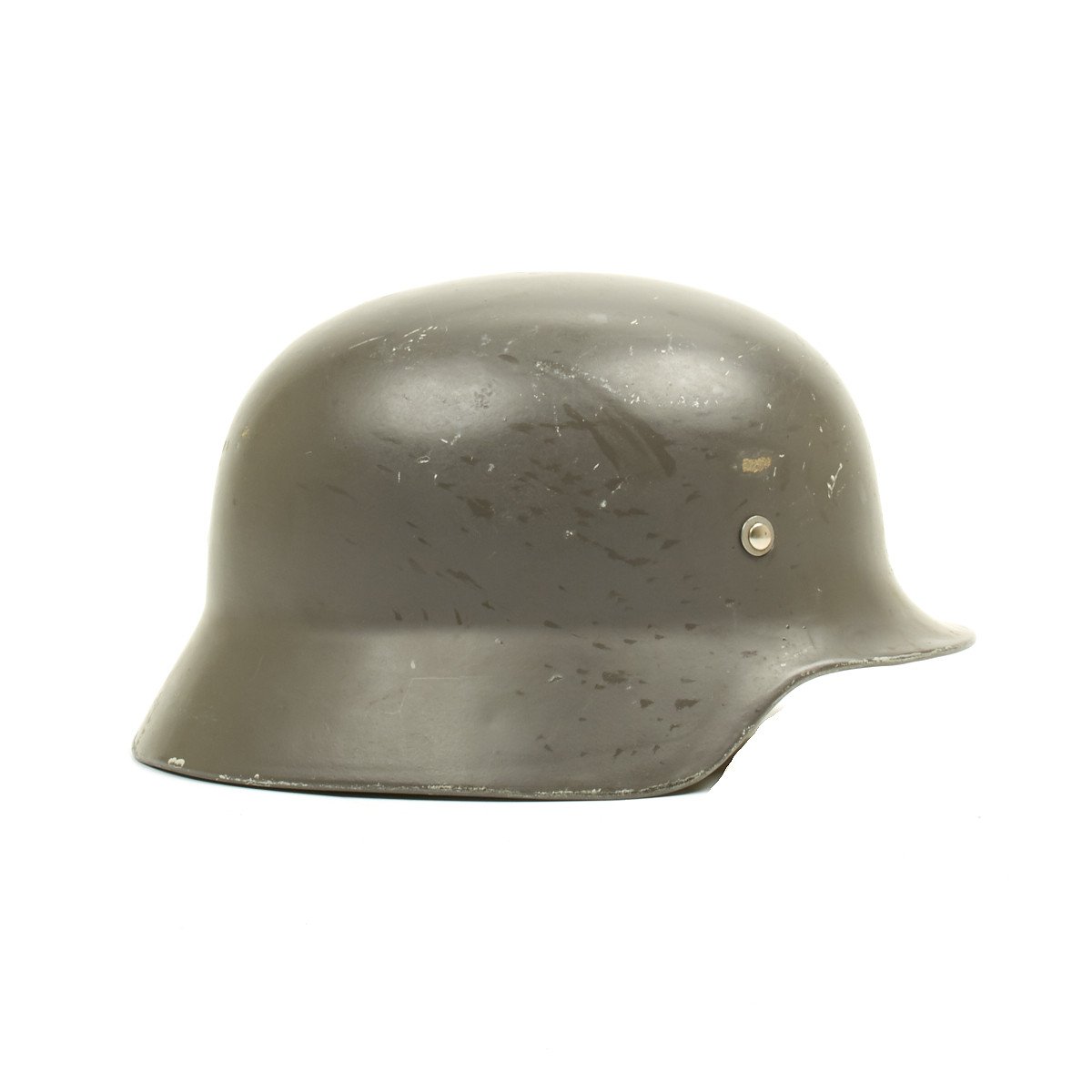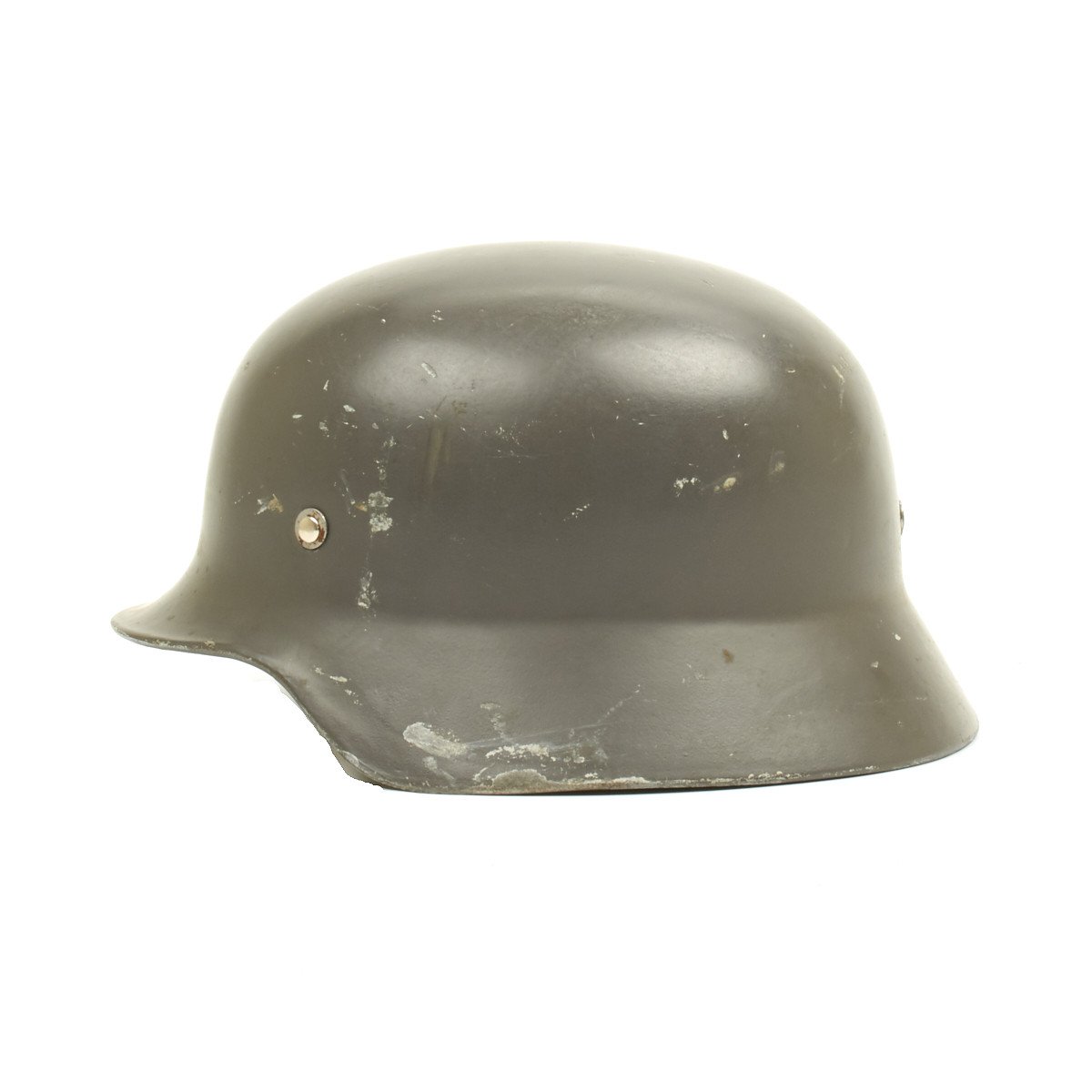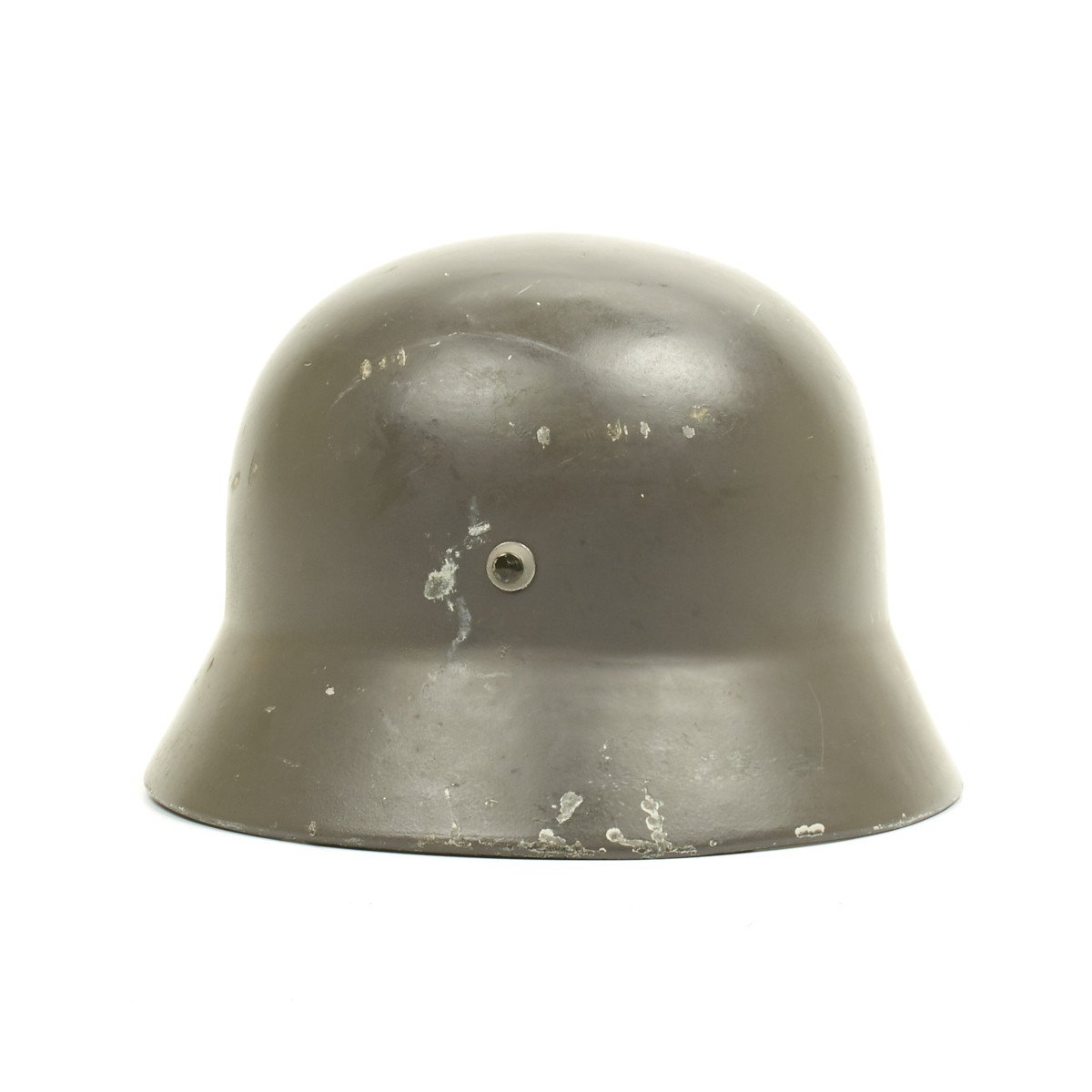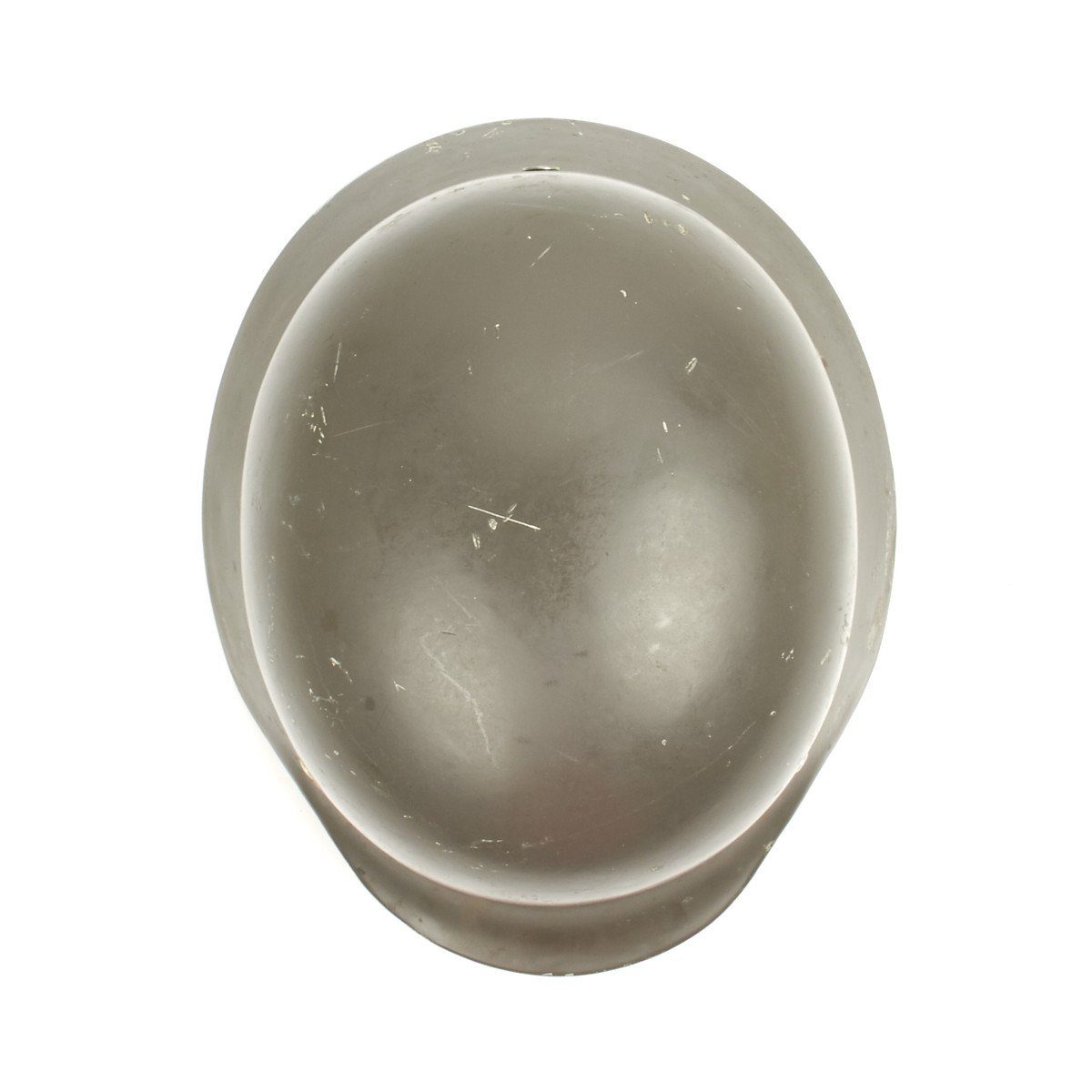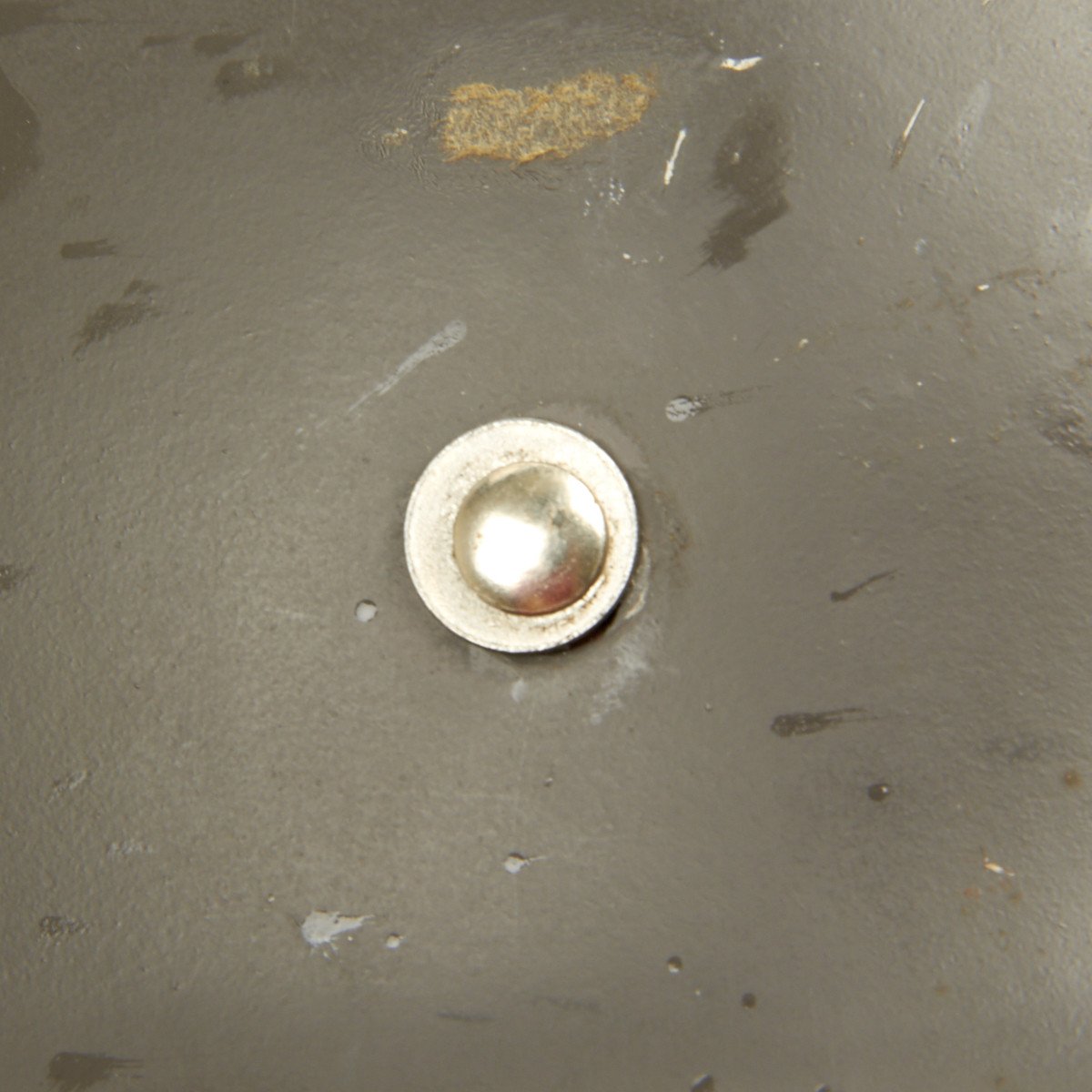Original German Bundesgrenzchutz Stahlhelm M53 Helmet Original Items
$ 99,95 $ 49,98
Original Item: Only a few available. We found a handful of these very interesting helmets in our massive purchase from the Finnish government in 2012. Each helmet was manufactured by Linnemann-Schneztler in West Germany in 1953. However, these examples were probably never used by the Bundesgrenzchutz and instead wound up in the large sale to Finland in 1955. They are unique due to the fact that they have no ventilation holes, but do maintain all aspects of a classic German M35 helmet including the shape and rolled edge. Our examples have Finnish made liners and are painted in Finnish colors (grey or green). Sizes vary (our choice).
This style helmet was produced for and used by the West-German Bundesgrenzschutz (Federal Border Patrol forces): half army, half police. It was organized by the Bund, the Union of German Länder (states), unlike the regular police force, which is organized by the different German states themselves. The BGS existed from 1951 on and was split into Bundesgrenzschutz and army in 1956.
They were also used by the Dominican Republic. The Dominican Republics use of the stahlhelm is unique in that the country never had even evaluated any other German helmet type, before, during, or after WWII. During the war, the Dominican Republics army (which was at the time, fairly advanced and disproportionately powerful in relation to the countrys size) received huge shipments of surplus M1917 helmets from the USA, which had replaced that type with the M1 pot. As WWII continued, more M1917s and some M1s were supplied under Lend-Lease.
The Dominican Republic was led by strongman Rafael Trujillo from 1931-1961. The USAs attitude towards Trujillo waxed and waned over the decades. Periodically, the USA would embargo weapons to the country. In the mid-1950s, during one such embargo, Trujillo decided he wanted to modernize his militarys appearance including replacing the pre-WWII M1917 helmets, some of which embarrassingly remained in use. Trujillos political stance ruled out any helmet of Soviet origin, and since pretty much most of the free world was using American-supplied M1 pot at that time, the options were limited.
A solution was found in the stahlhelm used by the Bundesgrenzchutz (Federal Border Police) of West Germany. Formed when West German sovereignty was re-established in 1949, the Bundesgrenzchutz patrolled the inter-German border which was literally the crease of the Cold War, where a Warsaw Pact attack might come at any moment. As such, it had a decidedly para-military character in weapons and uniforms. For reasons both financial and political, the Bundesgrenzchutz was initially equipped with WWII stahlhelms donated back by the western Allies. These were a mixture of the standard stahlhelm M35, and its wartime M40 and M42 versions. These were cleaned, stripped of any Wehrmacht or Waffen-SS markings, repainted, and reissued. This saved scarce money for the Bundesgrenzchutz and also differentiated it from the Bundeswehr, which used the M1 pot.
By the 1950s, these helmets were wearing out. A new production run was ordered. Designated stahlhelm M53, or sometimes M35/53, these are regarded as the final true members of the stahlhelm family. The stahlhelm M53 was generally identical in shape to the wartime M40 version of the M35, however the ventilation holes were omitted. The leather suspension was a sort of hybrid between the stahlhelm M35 and that used on the M1 pot. These stahlhelm M53s remained in West German Bundesgrenzchutz use until the two Germanys reunited in 1990.
In the Dominican Republic, the stahlhelm M53 was viewed as an ideal choice as it bypassed the American embargo, and was obviously a proven successful helmet design. Additionally in any future war against arch-rival Haiti, it would be differentiated on the battlefield from that countrys army which exclusively used M1 pots.
Several thousand were imported during the mid-1950s. All of the Dominican Republics stahlhelm M53s were manufactured by Linnemann-Schneztler in West Germany. As delivered, they were painted matte blackish-brown. Some diverted to the Dominican Republic navy were repainted sea blue, while a few that went to the countrys air force had large pilot wings painted on them.
Almost all went to the army, and the quantity delivered was not sufficient to re-equip all divisions. The Guardia Presedencial was the first unit to convert to the stahlhelm, followed by select infantry battalions. The helmet was well-liked by Dominican Republic soldiers.
After Trujillos assassination in 1961, military aid was re-established by the USA and cheap supplies of M1 pot helmets ended the stahlhelm project. The stahlhelm M53s were viewed somewhat as a reminder of the Trujillo regime, and their public use after 1961 was muted.
On 30 April 1965, the United States invaded the Dominican Republic (operation Power Pack) and briefly occupied the country. When the Dominican Republic army was reformed with American help, it fully standardized on the M1 pot which was its exclusive helmet until the turn of the millennium. The stahlhelm M53s were mostly melted as scrap and today, ex-Dominican Republic stahlhelms are extremely rare for collectors.
| Hand Select | No, Yes |
|---|
Fast Shipping with Professional Packaging
Thanks to our longstanding association with UPS FedEx DHL, and other major international carriers, we are able to provide a range of shipping options. Our warehouse staff is expertly trained and will wrap your products according to our exact and precise specifications. Prior to shipping, your goods will be thoroughly examined and securely secured. We ship to thousands clients each day across multiple countries. This shows how we're dedicated to be the largest retailer on the internet. Warehouses and distribution centres can be located throughout Europe as well as the USA.
Note: Orders with more than one item will be assigned a processing date depending on the item.
Before shipping before shipping, we'll conduct a thorough inspection of the items you have ordered. Today, the majority of orders will be delivered within 48 hours. The delivery time will be between 3-7 days.
Returns
The stock is dynamic and we cannot completely manage it because multiple stakeholders are involved, including our factory and warehouse. So the actual stock may alter at any time. It's possible that you may not receive your order once the order has been made.
Our policy is valid for a period of 30 days. If you don't receive the product within 30 days, we are not able to issue a refund or an exchange.
You can only return an item if it is unused and in the same state as the day you received it. You must have the item in its original packaging.
Related products
Uncategorized
Uncategorized
Uncategorized
Uncategorized
Uncategorized
Armoured Fighting Vehicles of the World: AFVs of World War One (Hardcover Book) New Made Items
Uncategorized
Australian WWII Owen MK1 Machine Carbine SMG Custom Fabricated Replica with Sling Original Items
Uncategorized
Band of Brothers ORIGINAL GERMAN WWII Le. F.H. 18 10.5cm ARTILLERY PIECE Original Items
Uncategorized
Uncategorized
Uncategorized
Uncategorized
Uncategorized
Uncategorized
Angolan Rebel 1970s era 60mm Inert Display Mortar from Angolan Civil War Original Items
Uncategorized
Uncategorized
Uncategorized
